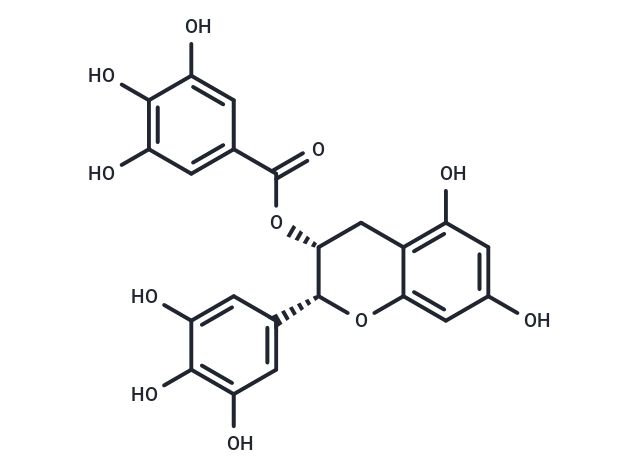Shopping Cart
- Remove All
 Your shopping cart is currently empty
Your shopping cart is currently empty

(-)-Epigallocatechin Gallate (EGCG) is a phenolic antioxidant polyphenol flavonoid found in plants such as green and black tea, which inhibits telomerase and DNA methyltransferase, blocks the activation of EGF receptors and HER-2 receptors, inhibits cellular oxidation, and prevents free radical damage to cells.

| Pack Size | Price | Availability | Quantity |
|---|---|---|---|
| 50 mg | $43 | In Stock | |
| 100 mg | $57 | In Stock | |
| 500 mg | $138 | In Stock | |
| 1 mL x 10 mM (in DMSO) | $39 | In Stock |
| Description | (-)-Epigallocatechin Gallate (EGCG) is a phenolic antioxidant polyphenol flavonoid found in plants such as green and black tea, which inhibits telomerase and DNA methyltransferase, blocks the activation of EGF receptors and HER-2 receptors, inhibits cellular oxidation, and prevents free radical damage to cells. |
| In vitro | METHODS: Human thyroid cancer cells TT, TPC-1 and ARO were treated with (-)-Epigallocatechin Gallate (10-200 µM) for 24 h. Cell viability was detected using MTS assay. |
| In vivo | METHODS: To investigate the protective effect against acute injury, (-)-Epigallocatechin Gallate (200 mg/kg) was administered to ICR mice by gavage once a day for one week, followed by intraperitoneal injection of LPS (15 mg/kg) to induce acute injury. RESULTS: (-)-Epigallocatechin Gallate protects mice from LPS-induced acute stress, while stabilizing gut microorganisms, improving sphingolipid metabolism, and inhibiting harmful metabolite levels. [3] |
| Cell Research | LoVo, SW480, HCT-8, and HT-29 cells are seeded in 96-well plates at a concentration of 5×103?cells; each cell line is totally seeded in the 12 wells. Complete medium is added to the wells, up to 200 μL; the medium contains 0 μg/mL, 10 μg/mL, 20 μg/mL, and 35 μg/mL of epigallocatechol gallate. The inhibition rate=[1 - (absorbance of Epigallocatechol Gallate group - absorbance of control group)/(absorbance of control group - absorbance of blank control group)] × 100. |
| Alias | Epigallocatechol Gallate, EGCG |
| Molecular Weight | 458.37 |
| Formula | C22H18O11 |
| Cas No. | 989-51-5 |
| Smiles | O(C(=O)C1=CC(O)=C(O)C(O)=C1)[C@H]2[C@H](OC=3C(C2)=C(O)C=C(O)C3)C4=CC(O)=C(O)C(O)=C4 |
| Relative Density. | 1.9g/cm3 |
| Storage | Powder: -20°C for 3 years | In solvent: -80°C for 1 year | Shipping with blue ice. | ||||||||||||||||||||||||||||||||||||||||
| Solubility Information | DMSO: 100 mg/mL (218.16 mM), Sonication is recommended. H2O: 50 mg/mL (109.08 mM), Sonication is recommended. Ethanol: 45.8 mg/mL (99.92 mM), Sonication is recommended. | ||||||||||||||||||||||||||||||||||||||||
Solution Preparation Table | |||||||||||||||||||||||||||||||||||||||||
Ethanol/H2O/DMSO
H2O/DMSO
| |||||||||||||||||||||||||||||||||||||||||

Copyright © 2015-2025 TargetMol Chemicals Inc. All Rights Reserved.